generator bolt SUZUKI SWIFT 2006 2.G Service Workshop Manual
[x] Cancel search | Manufacturer: SUZUKI, Model Year: 2006, Model line: SWIFT, Model: SUZUKI SWIFT 2006 2.GPages: 1496, PDF Size: 34.44 MB
Page 33 of 1496
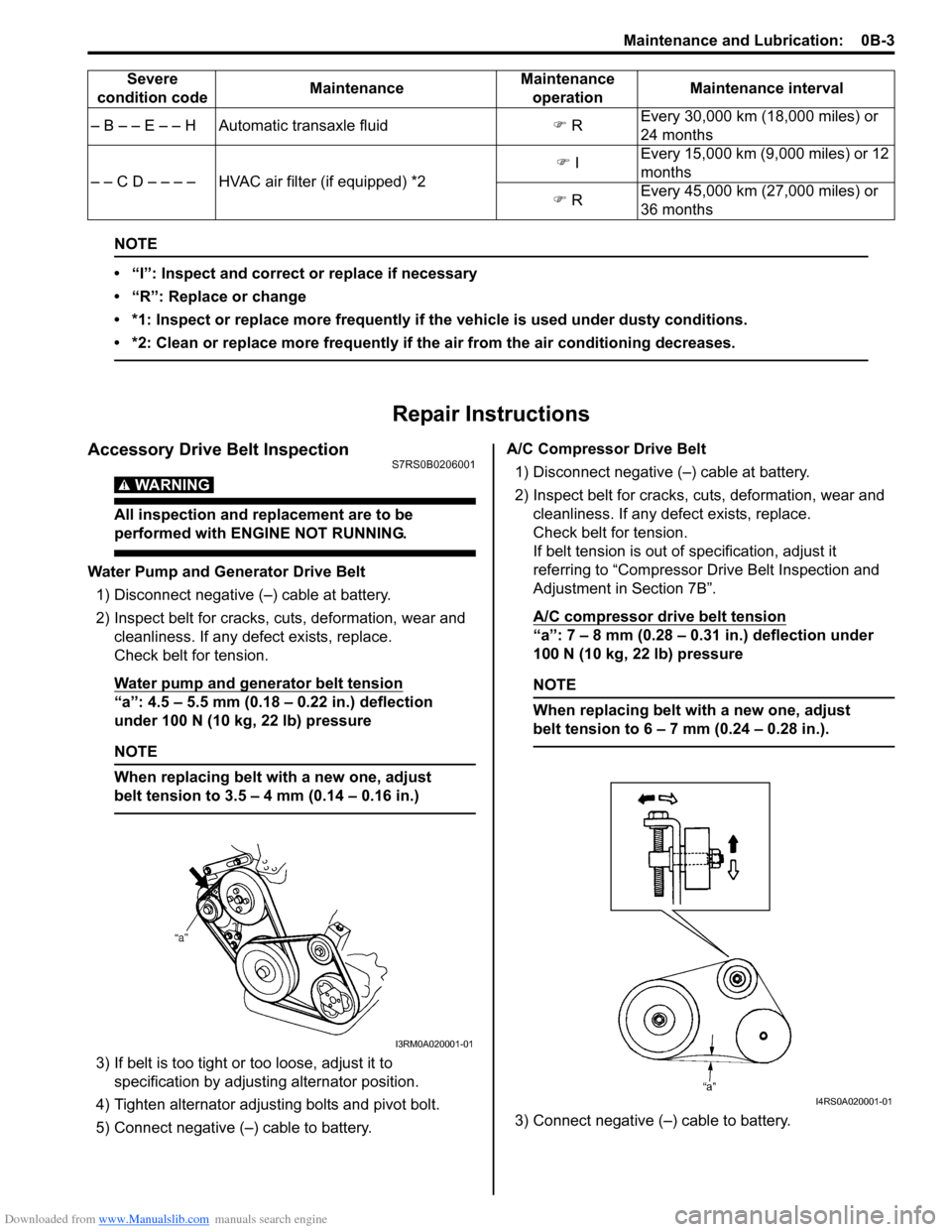
Downloaded from www.Manualslib.com manuals search engine Maintenance and Lubrication: 0B-3
NOTE
тАв тАЬIтАЭ: Inspect and correct or replace if necessary
тАв тАЬRтАЭ: Replace or change
тАв *1: Inspect or replace more frequently if the vehicle is used under dusty conditions.
тАв *2: Clean or replace more frequently if the air from the air conditioning decreases.
Repair Instructions
Accessory Drive Belt InspectionS7RS0B0206001
WARNING!
All inspection and replacement are to be
performed with ENGINE NOT RUNNING.
Water Pump and Generator Drive Belt1) Disconnect negative (тАУ) cable at battery.
2) Inspect belt for cracks, cu ts, deformation, wear and
cleanliness. If any defect exists, replace.
Check belt for tension.
Water pump and generator belt tension
тАЬaтАЭ: 4.5 тАУ 5.5 mm (0.18 тАУ 0.22 in.) deflection
under 100 N (10 kg, 22 lb) pressure
NOTE
When replacing belt with a new one, adjust
belt tension to 3.5 тАУ 4 mm (0.14 тАУ 0.16 in.)
3) If belt is too tight or too loose, adjust it to
specification by adjusting alternator position.
4) Tighten alternator adjusting bolts and pivot bolt.
5) Connect negative (тАУ) cable to battery. A/C Compressor Drive Belt
1) Disconnect negative (тАУ) cable at battery.
2) Inspect belt for cracks, cuts, deformation, wear and cleanliness. If any defect exists, replace.
Check belt for tension.
If belt tension is out of specification, adjust it
referring to тАЬCompressor Dr ive Belt Inspection and
Adjustment in Section 7BтАЭ.
A/C compressor drive belt tension
тАЬaтАЭ: 7 тАУ 8 mm (0.28 тАУ 0.31 in.) deflection under
100 N (10 kg, 22 lb) pressure
NOTE
When replacing belt with a new one, adjust
belt tension to 6 тАУ 7 mm (0.24 тАУ 0.28 in.).
3) Connect negative (тАУ) cable to battery.
тАУ B тАУ тАУ E тАУ тАУ H Automatic transaxle fluid
�) R Every 30,000 km (18,000 miles) or
24 months
тАУ тАУ C D тАУ тАУ тАУ тАУ HVAC air filter (if equipped) *2 �)
I Every 15,000 km (9,000 miles) or 12
months
�) R Every 45,000 km (27,000 miles) or
36 months
Severe
condition code MaintenanceMaintenance
operation Maintenance interval
I3RM0A020001-01
I4RS0A020001-01
Page 87 of 1496

Downloaded from www.Manualslib.com manuals search engine Engine General Information and Diagnosis: 1A-37
TP SENSOR 2 VOLT (THROTTLE POSITION SENSOR
(SUB) OUTPUT VOLTAGE, V)
The TP sensor (sub) reading provides throttle valve
opening information in the form of voltage.
APP SENSOR 1 VOLT (ACCELERATOR PEDAL
POSITION (APP) SENSOR (MAIN) OUTPUT
VOLTAGE, V)
The APP sensor (main) read ing provides accelerator
pedal opening information in the form of voltage.
APP SENSOR 2 VOLT (ACCELERATOR PEDAL
POSITION (APP) SENSOR (S UB) OUTPUT VOLTAGE,
V)
The APP sensor (sub) reading provides accelerator
pedal opening information in the form of voltage.
ACCEL POSITION (ABSOLUTE ACCELERATOR
PEDAL POSITION, %)
When accelerator pedal is at fully released position,
accelerator pedal is indicated as 0 тАУ 5% and 90 тАУ 100%
fully depressed position. THROTTLE TARGET POSI (TARGET THROTTLE
VALVE POSITION, %)
Target throttle valve position is ECM internal parameter
which indicates the ECM requested throttle valve
position.
BATTERY CURRENT (A)
This parameter indicates elec
tric load value (current
consumption) that detected by electric load current
sensor.
GENERATOR CONT DUTY (GENERATOR CONTROL
DUTY, %)
This parameter indicates generator control duty ratio that
controls production electricity of generator by ECM.
100%: No limitation for the generating
0%: Maximum limitation for the generating
GENERATOR FIELD DUTY (GENERATOR FIELD
COIL DUTY, %)
This parameter indicates ope rating rate (status of
production electricity) for gen erator by field coil duty
ratio.
100%: maximum operation.
0%: minimum operation.
Visual InspectionS7RS0B1104008
Visually check the following parts and systems.
Inspection item Reference section
тАв Engine oil тАУ level, leakage тАЬEngine Oil and Filter Change in Section 0BтАЭ
тАв Engine coolant тАУ level, leakage тАЬCo olant Level Check in Section 1FтАЭ
тАв Fuel тАУ level, leakage тАЬFuel Lines and Connections Inspection in Section 0BтАЭ
тАв Air cleaner element тАУ dirt, clogging тАЬAir Cleaner Filter Inspection in Section 0BтАЭ
тАв Battery тАУ fluid level, corrosion of terminal тАЬBattery Description in Section 1JтАЭ
тАв Water pump belt тАУ tension damage тАЬAccessory Drive Belt Inspection in Section 0BтАЭ
тАв Throttle valve тАУ operating sound тАЬElectric Throttle Body Assembly On-Vehicle Inspection in Section 1CтАЭ
тАв Vacuum hoses of air intake system тАУ disconnection, looseness,
deterioration, bend тАЬVacuum Hose and Purge Valve Chamber
Inspection in Section 1BтАЭ
тАв Connectors of electric wire harness тАУ disconnection, friction
тАв Fuses тАУ burning
тАв Parts тАУ installation, bolt тАУ looseness
тАв Parts тАУ deformation
тАв Other parts that can be checked visually
Also check the following items at engine start, if possible
тАв Malfunction indicator lamp тАУ Operation тАЬMalfunction Indicator Lamp (MIL) CheckтАЭ
тАв Charge warning lamp тАУ Operation тАЬGenera tor Symptom Diagnosis in Section 1JтАЭ
тАв Engine oil pressure warning lamp тАУ Operation тАЬO il Pressure Switch Inspection in Section 9CтАЭ
тАв Engine coolant temp. meter тАУ Operation тАЬECT Sensor Inspection in Section 1CтАЭ
тАв Fuel level meter тАУ Operation тАЬFuel Level Sensor Inspection in Section 9CтАЭ
тАв Tachometer тАУ Operation
тАв Abnormal air being inhaled from air intake system
тАв Exhaust system тАУ leakage of exhaust gas, noise
тАв Other parts that can be checked visually
Page 281 of 1496
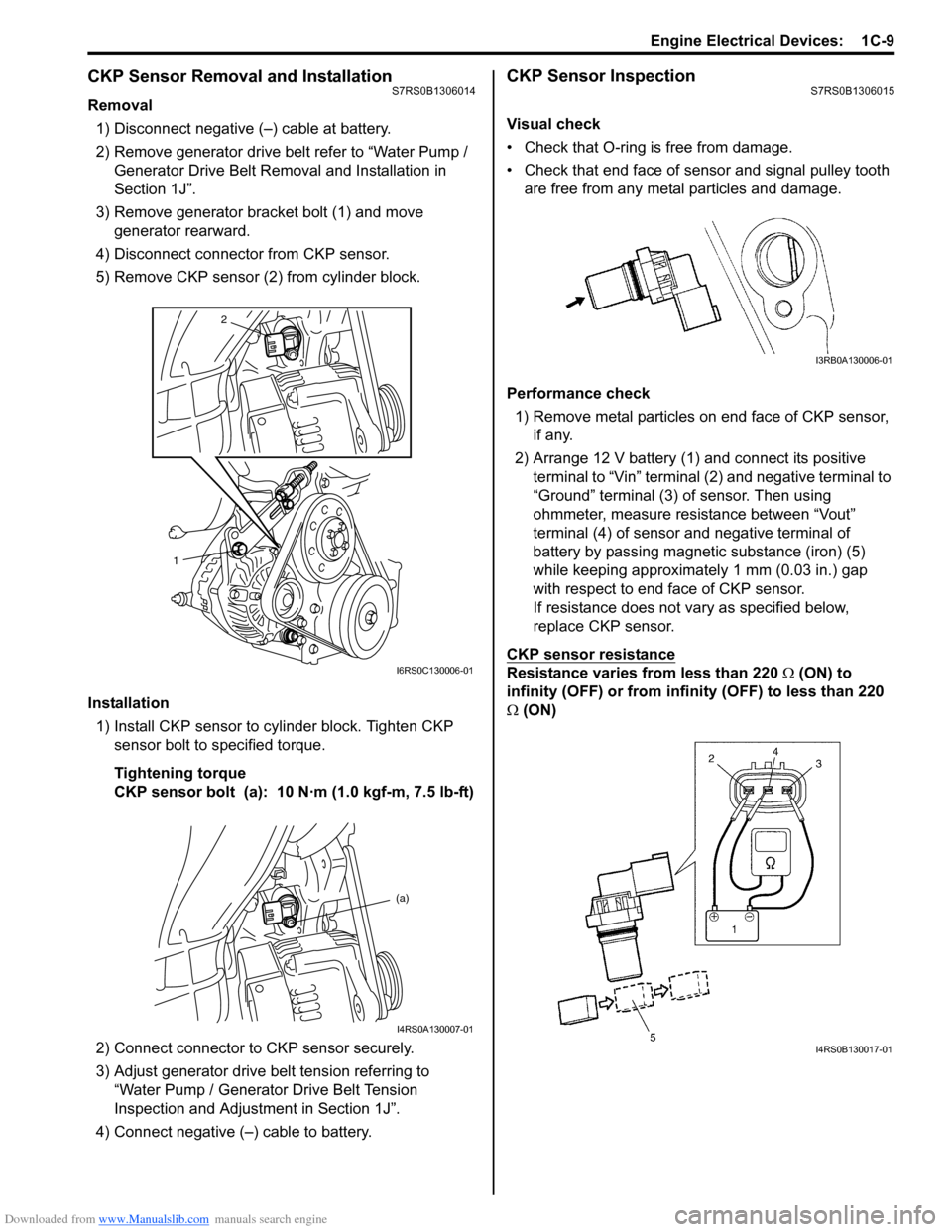
Downloaded from www.Manualslib.com manuals search engine Engine Electrical Devices: 1C-9
CKP Sensor Removal and InstallationS7RS0B1306014
Removal1) Disconnect negative (тАУ) cable at battery.
2) Remove generator drive belt refer to тАЬWater Pump / Generator Drive Belt Remo val and Installation in
Section 1JтАЭ.
3) Remove generator bracket bolt (1) and move generator rearward.
4) Disconnect connector from CKP sensor.
5) Remove CKP sensor (2) from cylinder block.
Installation 1) Install CKP sensor to cylinder block. Tighten CKP sensor bolt to specified torque.
Tightening torque
CKP sensor bolt (a): 10 N┬╖m (1.0 kgf-m, 7.5 lb-ft)
2) Connect connector to CKP sensor securely.
3) Adjust generator drive belt tension referring to тАЬWater Pump / Generator Drive Belt Tension
Inspection and Adjustment in Section 1JтАЭ.
4) Connect negative (тАУ) cable to battery.
CKP Sensor InspectionS7RS0B1306015
Visual check
тАв Check that O-ring is free from damage.
тАв Check that end face of sensor and signal pulley tooth are free from any metal particles and damage.
Performance check 1) Remove metal particles on end face of CKP sensor, if any.
2) Arrange 12 V battery (1) and connect its positive terminal to тАЬVinтАЭ terminal (2) and negative terminal to
тАЬGroundтАЭ terminal (3) of sensor. Then using
ohmmeter, measure resistance between тАЬVoutтАЭ
terminal (4) of sensor and negative terminal of
battery by passing magnetic substance (iron) (5)
while keeping approximately 1 mm (0.03 in.) gap
with respect to end face of CKP sensor.
If resistance does not vary as specified below,
replace CKP sensor.
CKP sensor resistance
Resistance varies from less than 220 тДж (ON) to
infinity (OFF) or from infinity (OFF) to less than 220
тДж (ON)
2
1
I6RS0C130006-01
(a)
I4RS0A130007-01
I3RB0A130006-01
I4RS0B130017-01
Page 285 of 1496
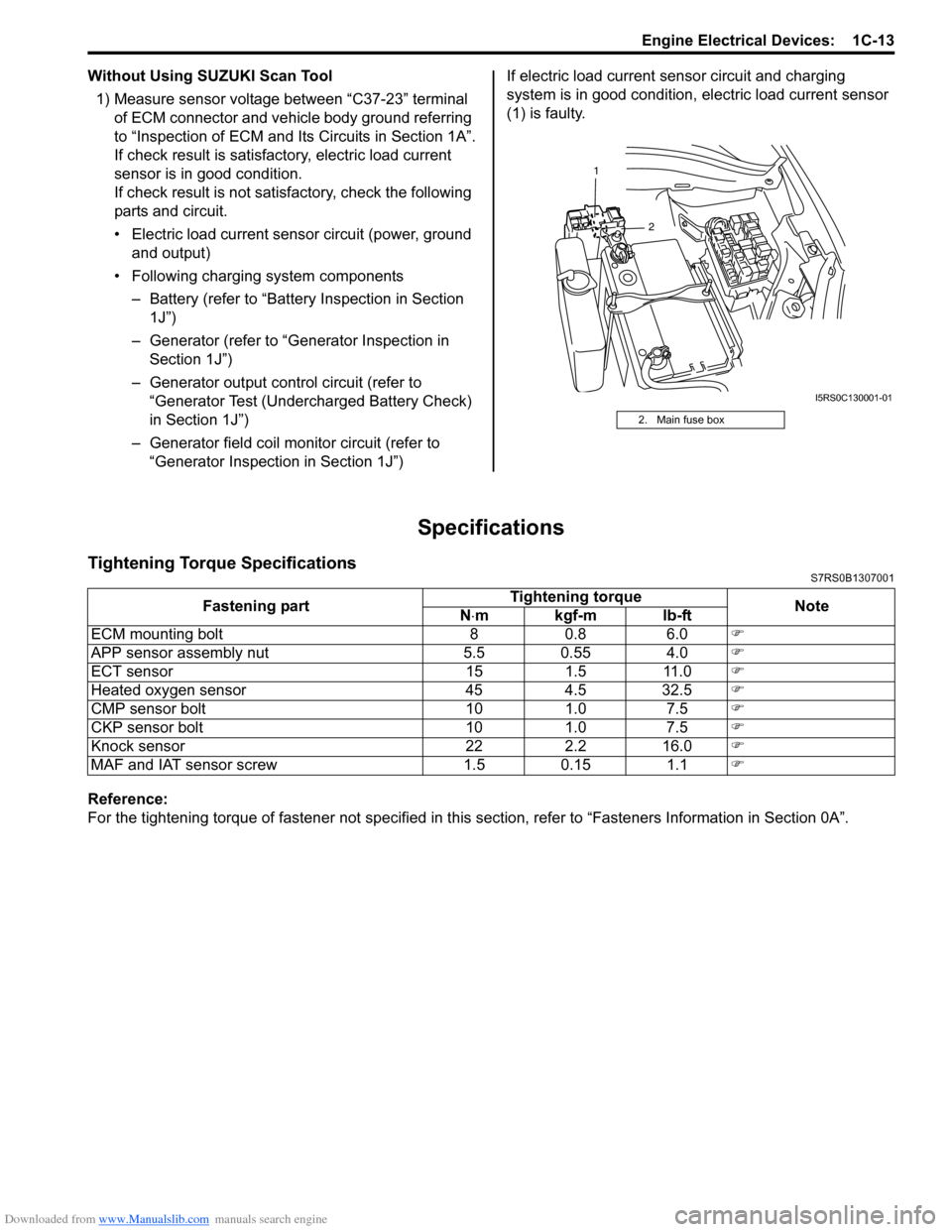
Downloaded from www.Manualslib.com manuals search engine Engine Electrical Devices: 1C-13
Without Using SUZUKI Scan Tool1) Measure sensor voltage between тАЬC37-23тАЭ terminal of ECM connector and vehicle body ground referring
to тАЬInspection of ECM and Its Circuits in Section 1AтАЭ.
If check result is satisfactory, electric load current
sensor is in good condition.
If check result is not satisfactory, check the following
parts and circuit.
тАв Electric load current sensor circuit (power, ground and output)
тАв Following charging system components тАУ Battery (refer to тАЬBattery Inspection in Section
1JтАЭ)
тАУ Generator (refer to тАЬGenerator Inspection in Section 1JтАЭ)
тАУ Generator output control circuit (refer to тАЬGenerator Test (Undercharged Battery Check)
in Section 1JтАЭ)
тАУ Generator field coil monitor circuit (refer to тАЬGenerator Inspection in Section 1JтАЭ) If electric load current sensor circuit and charging
system is in good condition,
electric load current sensor
(1) is faulty.
Specifications
Tightening Torque SpecificationsS7RS0B1307001
Reference:
For the tightening torque of fastener not specified in this section, refer to тАЬFasteners Information in Section 0AтАЭ.
2. Main fuse box
2
1
I5RS0C130001-01
Fastening part
Tightening torque
Note
N тЛЕmkgf-mlb-ft
ECM mounting bolt 8 0.8 6.0 �)
APP sensor assembly nut 5.5 0.55 4.0 �)
ECT sensor 15 1.5 11.0 �)
Heated oxygen sensor 45 4.5 32.5 �)
CMP sensor bolt 10 1.0 7.5 �)
CKP sensor bolt 10 1.0 7.5 �)
Knock sensor 22 2.2 16.0 �)
MAF and IAT sensor screw 1.5 0.15 1.1 �)
Page 304 of 1496
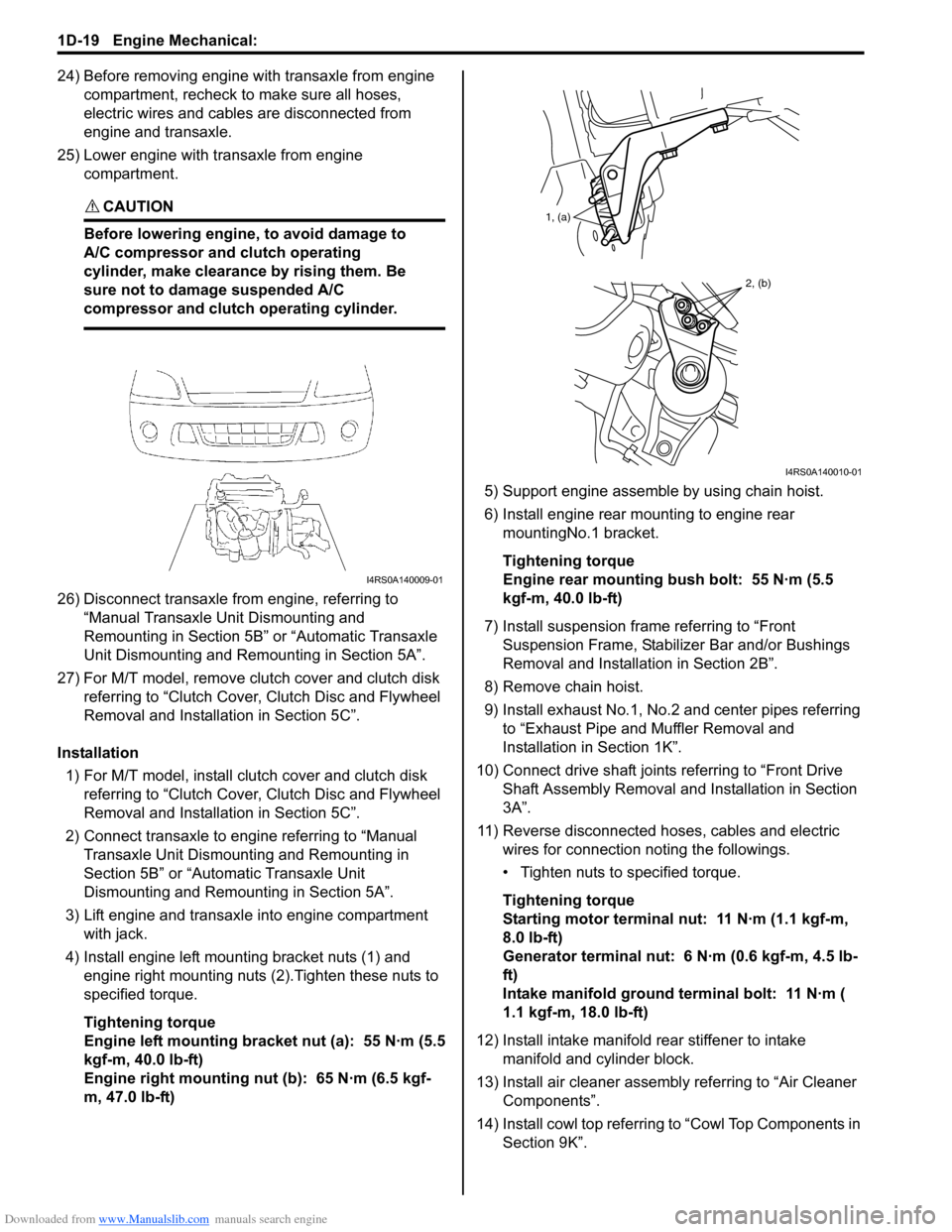
Downloaded from www.Manualslib.com manuals search engine 1D-19 Engine Mechanical:
24) Before removing engine with transaxle from engine compartment, recheck to make sure all hoses,
electric wires and cables are disconnected from
engine and transaxle.
25) Lower engine with transaxle from engine compartment.
CAUTION!
Before lowering engine, to avoid damage to
A/C compressor and clutch operating
cylinder, make clearance by rising them. Be
sure not to damage suspended A/C
compressor and clutch operating cylinder.
26) Disconnect transaxle from engine, referring to тАЬManual Transaxle Unit Dismounting and
Remounting in Section 5BтАЭ or тАЬAutomatic Transaxle
Unit Dismounting and Re mounting in Section 5AтАЭ.
27) For M/T model, remove clutch cover and clutch disk referring to тАЬClutch Cover, Clutch Disc and Flywheel
Removal and Installa tion in Section 5CтАЭ.
Installation 1) For M/T model, install clutch cover and clutch disk referring to тАЬClutch Cover, Clutch Disc and Flywheel
Removal and Installa tion in Section 5CтАЭ.
2) Connect transaxle to engine referring to тАЬManual Transaxle Unit Dismounting and Remounting in
Section 5BтАЭ or тАЬAutomatic Transaxle Unit
Dismounting and Remounting in Section 5AтАЭ.
3) Lift engine and transaxle into engine compartment with jack.
4) Install engine left mounting bracket nuts (1) and engine right mounting nuts (2).Tighten these nuts to
specified torque.
Tightening torque
Engine left mounting bracket nut (a): 55 N┬╖m (5.5
kgf-m, 40.0 lb-ft)
Engine right mounting nut (b): 65 N┬╖m (6.5 kgf-
m, 47.0 lb-ft) 5) Support engine assemble by using chain hoist.
6) Install engine rear mounting to engine rear
mountingNo.1 bracket.
Tightening torque
Engine rear mounting bush bolt: 55 N┬╖m (5.5
kgf-m, 40.0 lb-ft)
7) Install suspension frame referring to тАЬFront Suspension Frame, Stabiliz er Bar and/or Bushings
Removal and Installati on in Section 2BтАЭ.
8) Remove chain hoist.
9) Install exhaust No.1, No.2 and center pipes referring to тАЬExhaust Pipe and Muffler Removal and
Installation in Section 1KтАЭ.
10) Connect drive shaft joints referring to тАЬFront Drive Shaft Assembly Removal and Installation in Section
3AтАЭ.
11) Reverse disconnected hoses, cables and electric wires for connection noting the followings.
тАв Tighten nuts to specified torque.
Tightening torque
Starting motor terminal nut: 11 N┬╖m (1.1 kgf-m,
8.0 lb-ft)
Generator terminal nut: 6 N┬╖m (0.6 kgf-m, 4.5 lb-
ft)
Intake manifold ground terminal bolt: 11 N┬╖m (
1.1 kgf-m, 18.0 lb-ft)
12) Install intake manifold rear stiffener to intake
manifold and cylinder block.
13) Install air cleaner assembly referring to тАЬAir Cleaner ComponentsтАЭ.
14) Install cowl top referring to тАЬCowl Top Components in
Section 9KтАЭ.
I4RS0A140009-01
1, (a)
2, (b)
I4RS0A140010-01
Page 306 of 1496

Downloaded from www.Manualslib.com manuals search engine 1D-21 Engine Mechanical:
Timing Chain Cover Removal and InstallationS7RS0B1406013
CAUTION!
тАв Keep working table, tools and hands clean while overhauling.
тАв Use special care to handle aluminum parts so as not to damage them.
тАв Do not expose removed parts to dust. Keep them always clean.
Removal
1) Remove engine assembly from vehicle referring to тАЬEngine Assembly Removal and InstallationтАЭ.
2) Remove water pump / generator drive belt referring to тАЬWater Pump / Generator Drive Belt Removal and
Installation in Section 1JтАЭ.
3) Remove crankshaft pulley bolt. To lock crankshaft pulley (1), use special tool with it
as shown in figure.
Special tool
(A): 09917тАУ68221
4) Remove crankshaft pulley (1). If it is hard to remove, use special tools as shown in
figure.
Special tool
(A): 09944тАУ36011
(B): 09926тАУ58010 5) Remove cylinder head cove
r referring to тАЬCylinder
Head Cover Removal and InstallationтАЭ.
6) Remove oil pan referring to тАЬOil Pan and Oil Pump
Strainer Removal and Inst allation in Section 1EтАЭ.
7) Remove water pump pulley.
8) Remove A/C bracket from cylinder block.
9) Remove oil gallery pipe s No.2 (1) and No.3 (2).
10) Remove cap (1) from timing chain cover (2). 11) Remove timing chain cover (2).
12) Remove oil control valve from timing chain cover referring to тАЬOil Cont rol Valve Removal and
InstallationтАЭ.
10. Copper washer :30 NтЛЕm (3.0 kgf-m, 22.0 lb-ft)
11. Oil gallery pipe No.1 bolt : 150 NтЛЕm (15.0 kgf-m, 108.5 lb-ft)
12. Oil gallery pipe No.2 : Do not reuse.
I2RH0B140051-01
I2RH0B140052-01
1
2
I3RH0B140021-01
1 2
I3RH0B140022-01
Page 349 of 1496
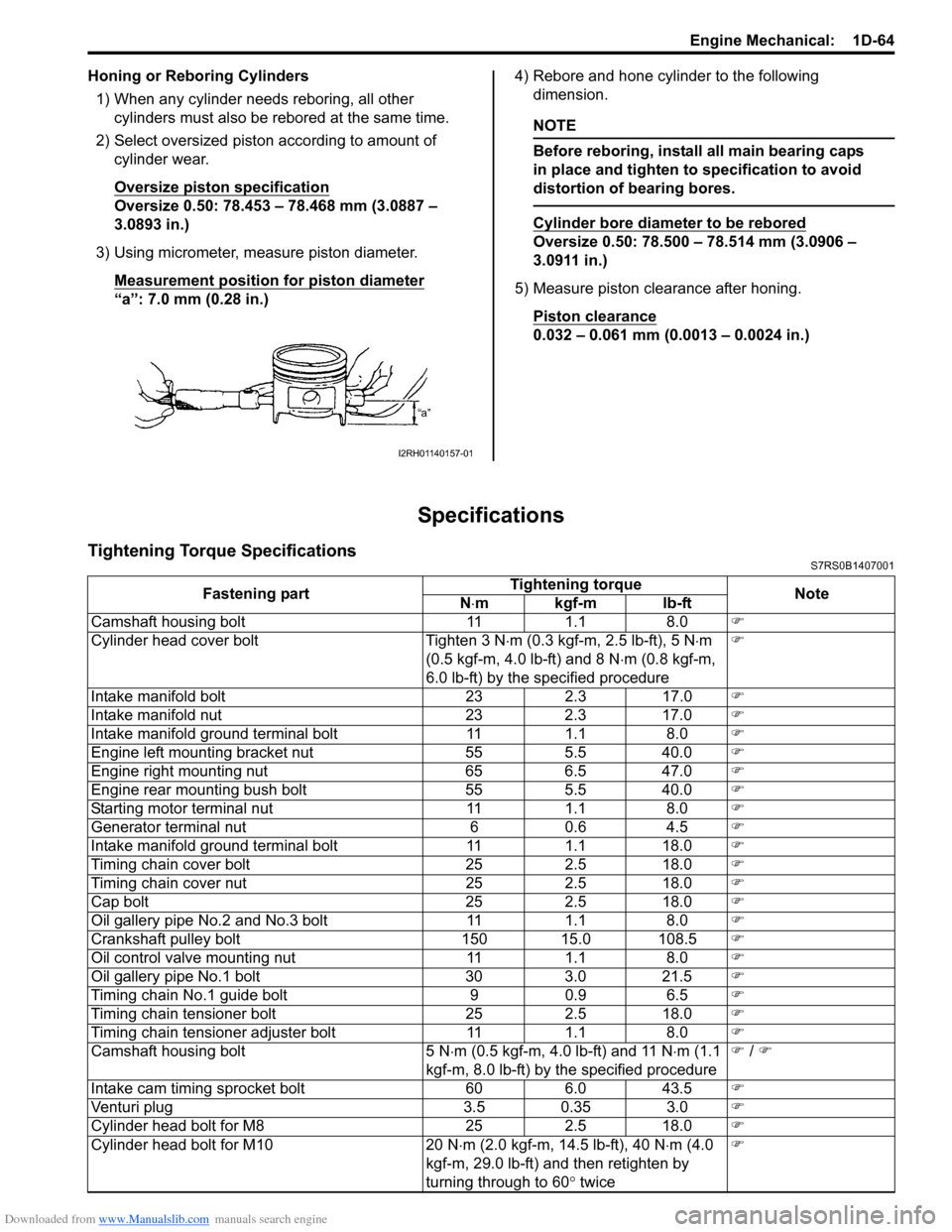
Downloaded from www.Manualslib.com manuals search engine Engine Mechanical: 1D-64
Honing or Reboring Cylinders1) When any cylinder needs reboring, all other cylinders must also be rebored at the same time.
2) Select oversized piston according to amount of cylinder wear.
Oversize piston specification
Oversize 0.50: 78.453 тАУ 78.468 mm (3.0887 тАУ
3.0893 in.)
3) Using micrometer, measure piston diameter. Measurement position for piston diameter
тАЬaтАЭ: 7.0 mm (0.28 in.) 4) Rebore and hone cylinder to the following
dimension.
NOTE
Before reboring, install all main bearing caps
in place and tighten to specification to avoid
distortion of bearing bores.
Cylinder bore diameter to be rebored
Oversize 0.50: 78.500 тАУ 78.514 mm (3.0906 тАУ
3.0911 in.)
5) Measure piston clearance after honing. Piston clearance
0.032 тАУ 0.061 mm (0.0013 тАУ 0.0024 in.)
Specifications
Tightening Torque SpecificationsS7RS0B1407001
I2RH01140157-01
Fastening part Tightening torque
Note
N тЛЕmkgf-mlb-ft
Camshaft housing bolt 11 1.1 8.0 �)
Cylinder head cover bolt Tighten 3 N тЛЕm (0.3 kgf-m, 2.5 lb-ft), 5 N тЛЕm
(0.5 kgf-m, 4.0 lb-ft) and 8 N тЛЕm (0.8 kgf-m,
6.0 lb-ft) by the specified procedure �)
Intake manifold bolt 23 2.3 17.0 �)
Intake manifold nut 23 2.3 17.0 �)
Intake manifold ground terminal bolt 11 1.1 8.0 �)
Engine left mounting bracket nut 55 5.5 40.0 �)
Engine right mounting nut 65 6.5 47.0 �)
Engine rear mounting bush bolt 55 5.5 40.0 �)
Starting motor terminal nut 11 1.1 8.0 �)
Generator terminal nut 6 0.6 4.5 �)
Intake manifold ground terminal bolt 11 1.1 18.0 �)
Timing chain cover bolt 25 2.5 18.0 �)
Timing chain cover nut 25 2.5 18.0 �)
Cap bolt 25 2.5 18.0 �)
Oil gallery pipe No.2 and No.3 bolt 11 1.1 8.0 �)
Crankshaft pulley bolt 150 15.0 108.5 �)
Oil control valve mounting nut 11 1.1 8.0 �)
Oil gallery pipe No.1 bolt 30 3.0 21.5 �)
Timing chain No.1 guide bolt 9 0.9 6.5 �)
Timing chain tensioner bolt 25 2.5 18.0 �)
Timing chain tensioner adjuster bolt 11 1.1 8.0 �)
Camshaft housing bolt 5 N тЛЕm (0.5 kgf-m, 4.0 lb-ft) and 11 N тЛЕm (1.1
kgf-m, 8.0 lb-ft) by the specified procedure �)
/ �)
Intake cam timing sprocket bolt 60 6.0 43.5 �)
Venturi plug 3.5 0.35 3.0 �)
Cylinder head bolt for M8 25 2.5 18.0 �)
Cylinder head bolt for M10 20 N тЛЕm (2.0 kgf-m, 14.5 lb-ft), 40 N тЛЕm (4.0
kgf-m, 29.0 lb-ft) and then retighten by
turning through to 60 ┬░ twice �)
Page 374 of 1496
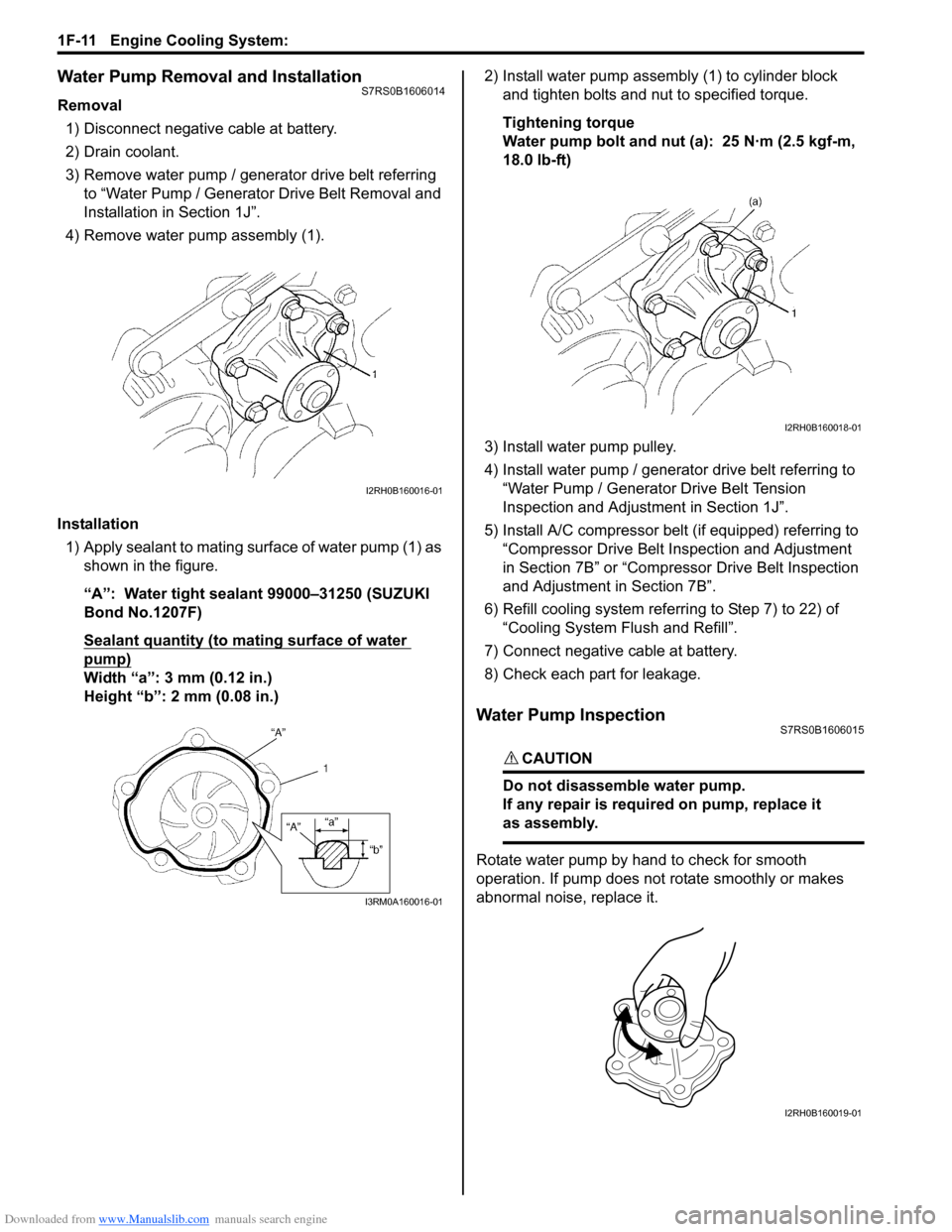
Downloaded from www.Manualslib.com manuals search engine 1F-11 Engine Cooling System:
Water Pump Removal and InstallationS7RS0B1606014
Removal1) Disconnect negative cable at battery.
2) Drain coolant.
3) Remove water pump / generator drive belt referring to тАЬWater Pump / Generator Drive Belt Removal and
Installation in Section 1JтАЭ.
4) Remove water pump assembly (1).
Installation 1) Apply sealant to mating surface of water pump (1) as shown in the figure.
тАЬAтАЭ: Water tight sealant 99000тАУ31250 (SUZUKI
Bond No.1207F)
Sealant quantity (to mating surface of water
pump)
Width тАЬaтАЭ: 3 mm (0.12 in.)
Height тАЬbтАЭ: 2 mm (0.08 in.) 2) Install water pump assemb
ly (1) to cylinder block
and tighten bolts and nut to specified torque.
Tightening torque
Water pump bolt and nut (a): 25 N┬╖m (2.5 kgf-m,
18.0 lb-ft)
3) Install water pump pulley.
4) Install water pump / generator drive belt referring to тАЬWater Pump / Generator Drive Belt Tension
Inspection and Adjustment in Section 1JтАЭ.
5) Install A/C compressor belt (if equipped) referring to тАЬCompressor Drive Belt Inspection and Adjustment
in Section 7BтАЭ or тАЬCompressor Drive Belt Inspection
and Adjustment in Section 7BтАЭ.
6) Refill cooling system referri ng to Step 7) to 22) of
тАЬCooling System Flush and RefillтАЭ.
7) Connect negative cable at battery.
8) Check each part for leakage.
Water Pump InspectionS7RS0B1606015
CAUTION!
Do not disassemble water pump.
If any repair is requir ed on pump, replace it
as assembly.
Rotate water pump by hand to check for smooth
operation. If pump does not rotate smoothly or makes
abnormal noise, replace it.
I2RH0B160016-01
I3RM0A160016-01
I2RH0B160018-01
I2RH0B160019-01
Page 411 of 1496
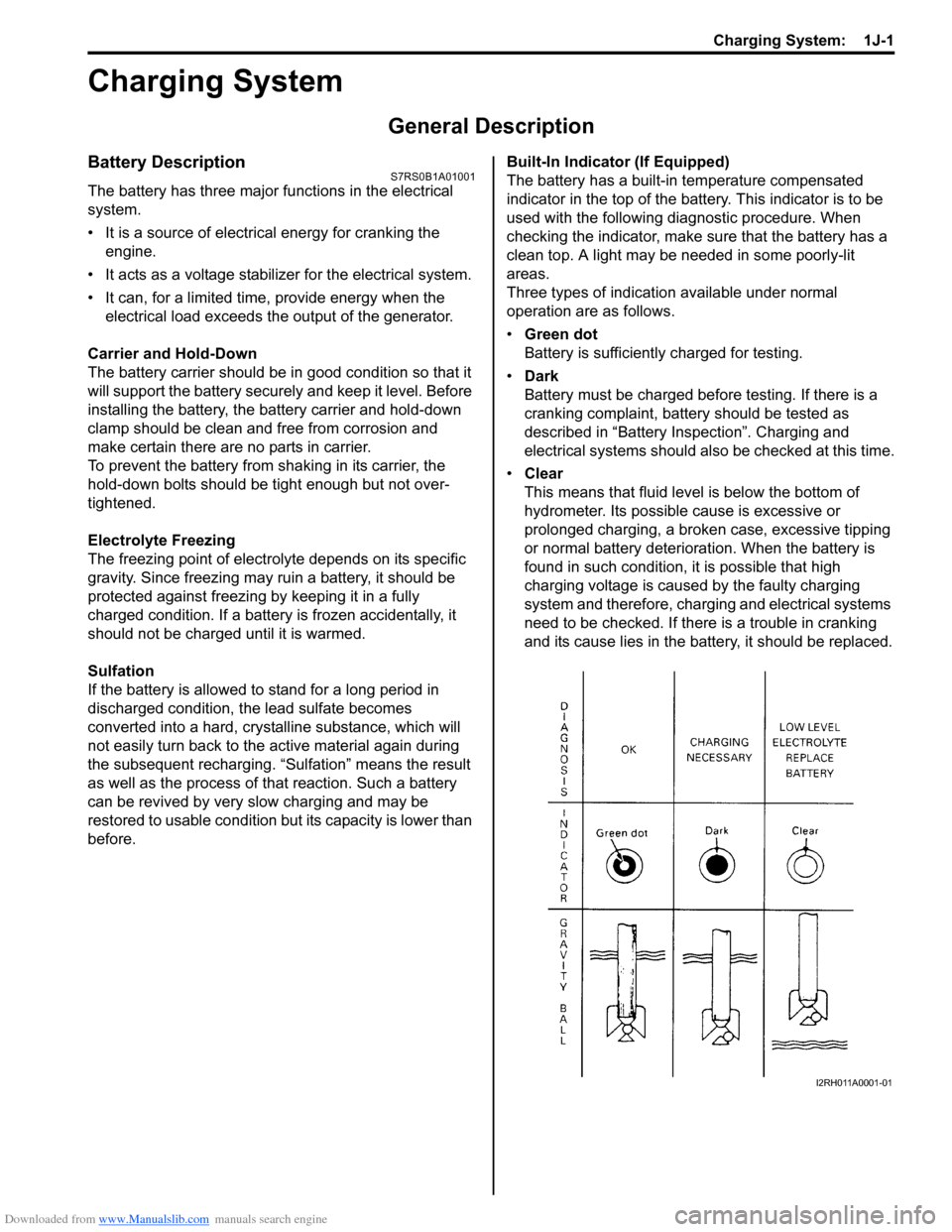
Downloaded from www.Manualslib.com manuals search engine Charging System: 1J-1
Engine
Charging System
General Description
Battery DescriptionS7RS0B1A01001
The battery has three major functions in the electrical
system.
тАв It is a source of electrical energy for cranking the engine.
тАв It acts as a voltage stabilizer for the electrical system.
тАв It can, for a limited time, provide energy when the electrical load exceeds the output of the generator.
Carrier and Hold-Down
The battery carrier should be in good condition so that it
will support the battery securely and keep it level. Before
installing the battery, the ba ttery carrier and hold-down
clamp should be clean and free from corrosion and
make certain there are no parts in carrier.
To prevent the battery from shaking in its carrier, the
hold-down bolts should be tight enough but not over-
tightened.
Electrolyte Freezing
The freezing point of electrolyte depends on its specific
gravity. Since freezing may ruin a battery, it should be
protected against freezing by keeping it in a fully
charged condition. If a battery is frozen accidentally, it
should not be charged until it is warmed.
Sulfation
If the battery is allowed to stand for a long period in
discharged condition, the lead sulfate becomes
converted into a hard, cryst alline substance, which will
not easily turn back to the active material again during
the subsequent recharging. тАЬSulfationтАЭ means the result
as well as the process of that reaction. Such a battery
can be revived by very slow charging and may be
restored to usable condition but its capacity is lower than
before. Built-In Indicator (If Equipped)
The battery has a built-in temperature compensated
indicator in the top of the battery. This indicator is to be
used with the following diagnostic procedure. When
checking the indicator, make sure that the battery has a
clean top. A light may be needed in some poorly-lit
areas.
Three types of indication available under normal
operation are as follows.
тАв
Green dot
Battery is sufficiently charged for testing.
тАв Dark
Battery must be charged before testing. If there is a
cranking complaint, battery should be tested as
described in тАЬBattery InspectionтАЭ. Charging and
electrical systems should also be checked at this time.
тАв Clear
This means that fluid level is below the bottom of
hydrometer. Its possible cause is excessive or
prolonged charging, a broken case, excessive tipping
or normal battery deteriorat ion. When the battery is
found in such condition, it is possible that high
charging voltage is caused by the faulty charging
system and therefore, charging and electrical systems
need to be checked. If there is a trouble in cranking
and its cause lies in the battery, it should be replaced.
I2RH011A0001-01
Page 414 of 1496
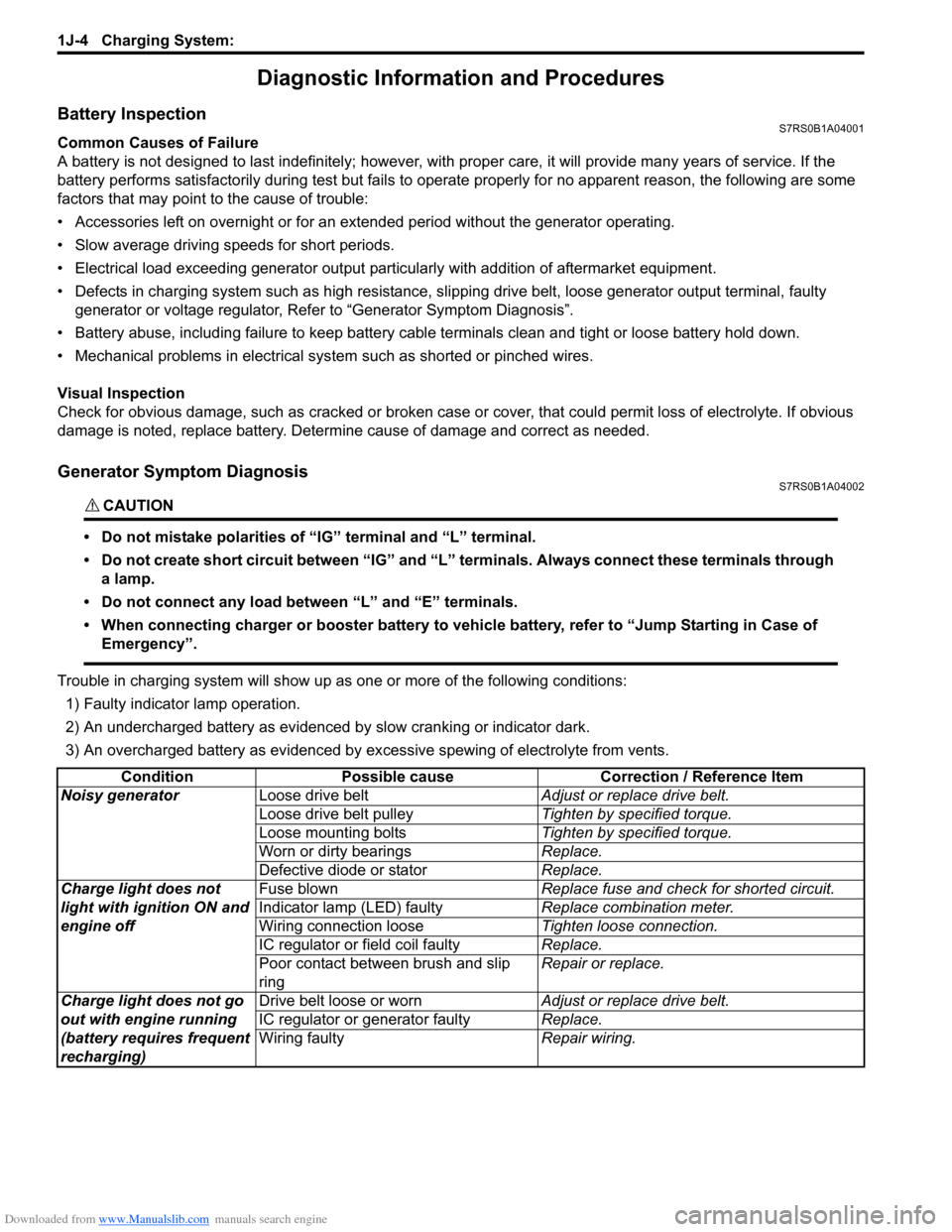
Downloaded from www.Manualslib.com manuals search engine 1J-4 Charging System:
Diagnostic Information and Procedures
Battery InspectionS7RS0B1A04001
Common Causes of Failure
A battery is not designed to last indefinitely; however, with proper care, it will provide many years of service. If the
battery performs satisfactorily during te st but fails to operate properly for no apparent reason, the following are some
factors that may point to the cause of trouble:
тАв Accessories left on overnight or for an extended period without the generator operating.
тАв Slow average driving speeds for short periods.
тАв Electrical load exceeding generator output partic ularly with addition of aftermarket equipment.
тАв Defects in charging system such as high resistance, s lipping drive belt, loose generator output terminal, faulty
generator or voltage regulator, Refer to тАЬGenerator Symptom DiagnosisтАЭ.
тАв Battery abuse, including failure to keep battery cable terminals clean and tight or loose battery hold down.
тАв Mechanical problems in electrical sys tem such as shorted or pinched wires.
Visual Inspection
Check for obvious damage, such as cracked or broken case or cover, that could permit loss of electrolyte. If obvious
damage is noted, replace battery. Determine cause of damage and correct as needed.
Generator Symptom DiagnosisS7RS0B1A04002
CAUTION!
тАв Do not mistake polarities of тАЬIGтАЭ terminal and тАЬLтАЭ terminal.
тАв Do not create short circuit between тАЬIGтАЭ and тАЬLтАЭ terminals. Always connect these terminals through a lamp.
тАв Do not connect any load between тАЬLтАЭ and тАЬEтАЭ terminals.
тАв When connecting charger or booster battery to vehicle battery, refer to тАЬJump Starting in Case of EmergencyтАЭ.
Trouble in charging system will show up as one or more of the following conditions:
1) Faulty indicator lamp operation.
2) An undercharged battery as evidenced by slow cranking or indicator dark.
3) An overcharged battery as evidenced by ex cessive spewing of electrolyte from vents.
Condition Possible cause Correction / Reference Item
Noisy generator Loose drive belt Adjust or replace drive belt.
Loose drive belt pulley Tighten by specified torque.
Loose mounting bolts Tighten by specified torque.
Worn or dirty bearings Replace.
Defective diode or stator Replace.
Charge light does not
light with ignition ON and
engine off Fuse blown
Replace fuse and check for shorted circuit.
Indicator lamp (LED) faulty Replace combination meter.
Wiring connection loose Tighten loose connection.
IC regulator or field coil faulty Replace.
Poor contact between brush and slip
ring Repair or replace.
Charge light does not go
out with engine running
(battery requires frequent
recharging) Drive belt loose or worn
Adjust or replace drive belt.
IC regulator or generator faulty Replace.
Wiring faulty Repair wiring.